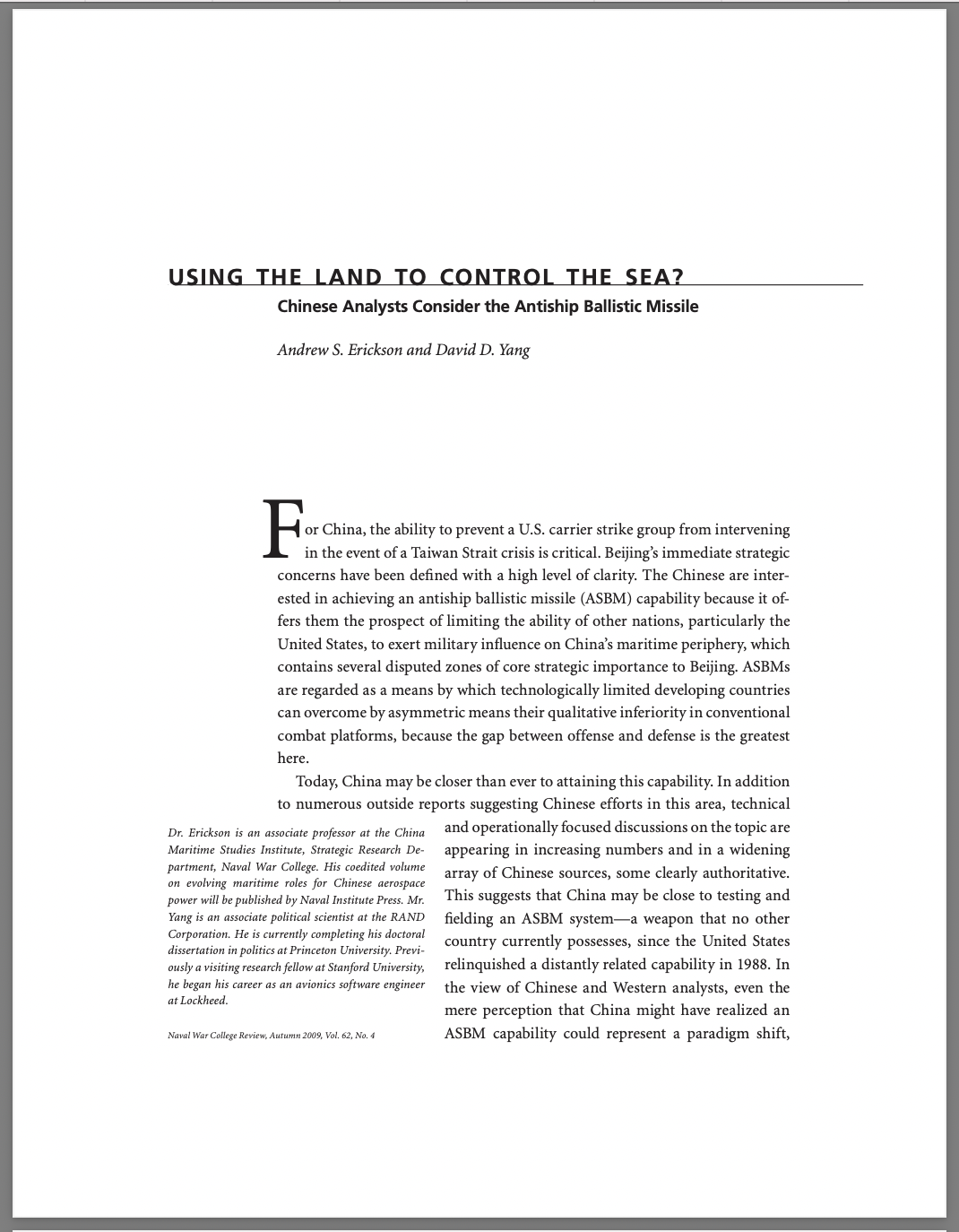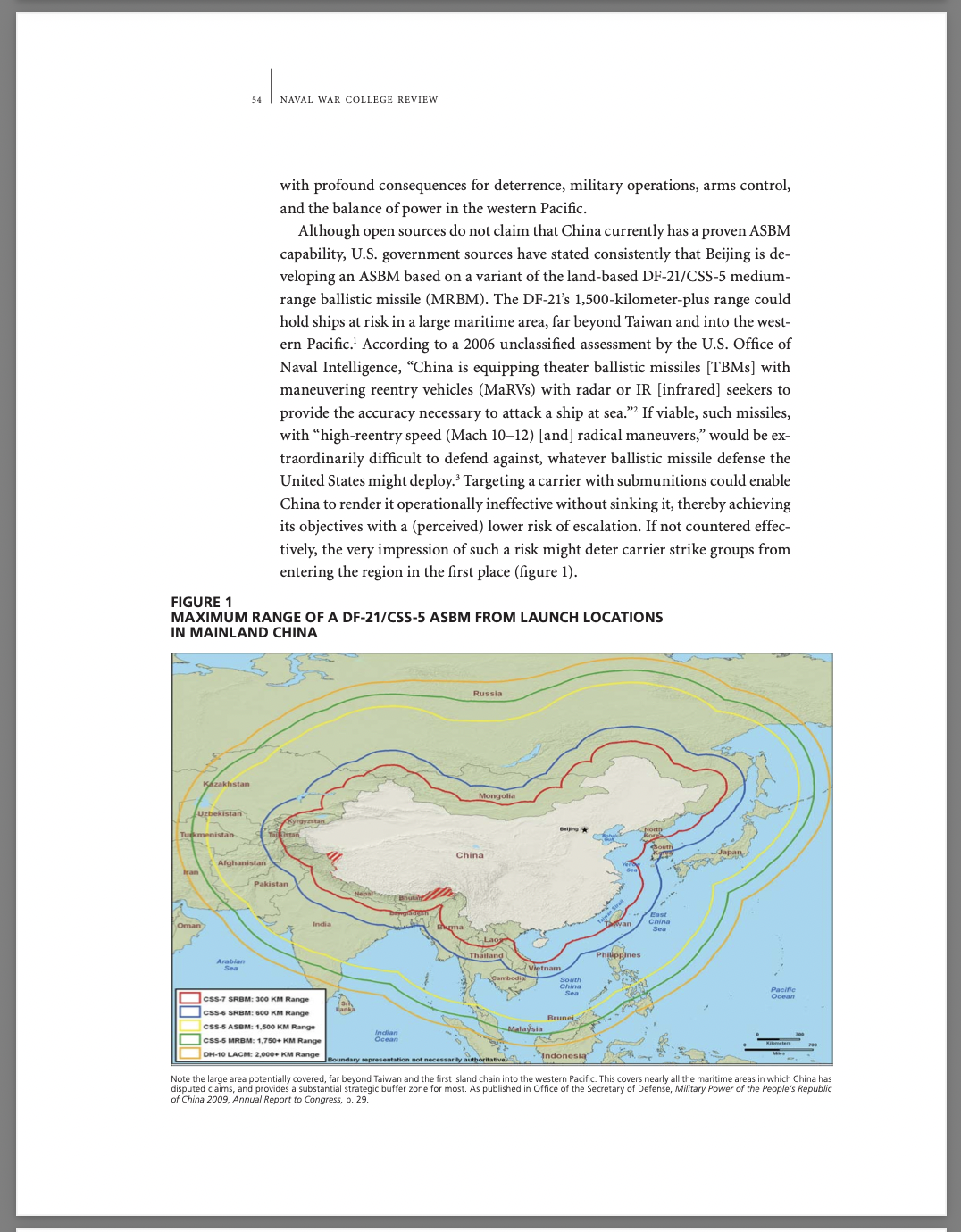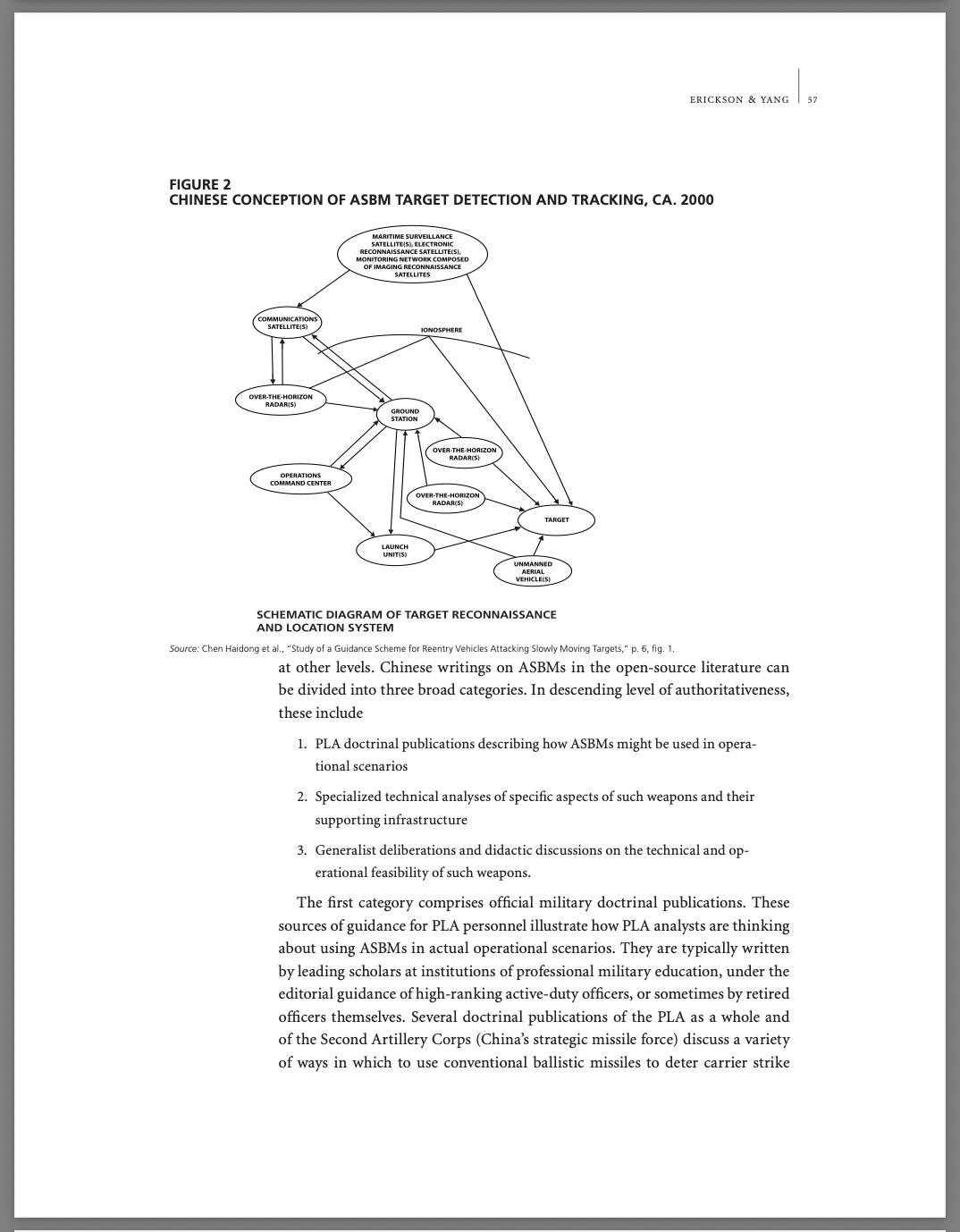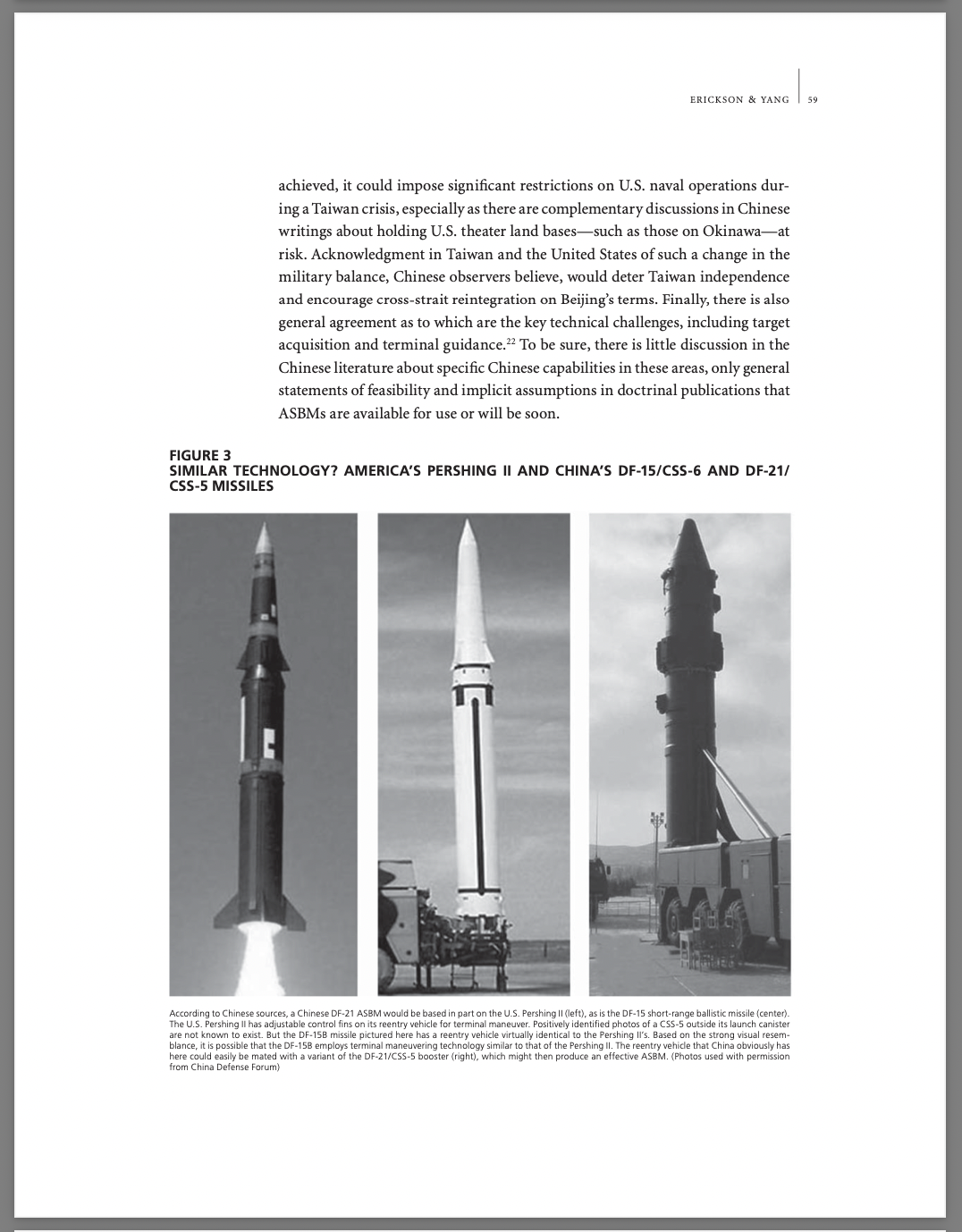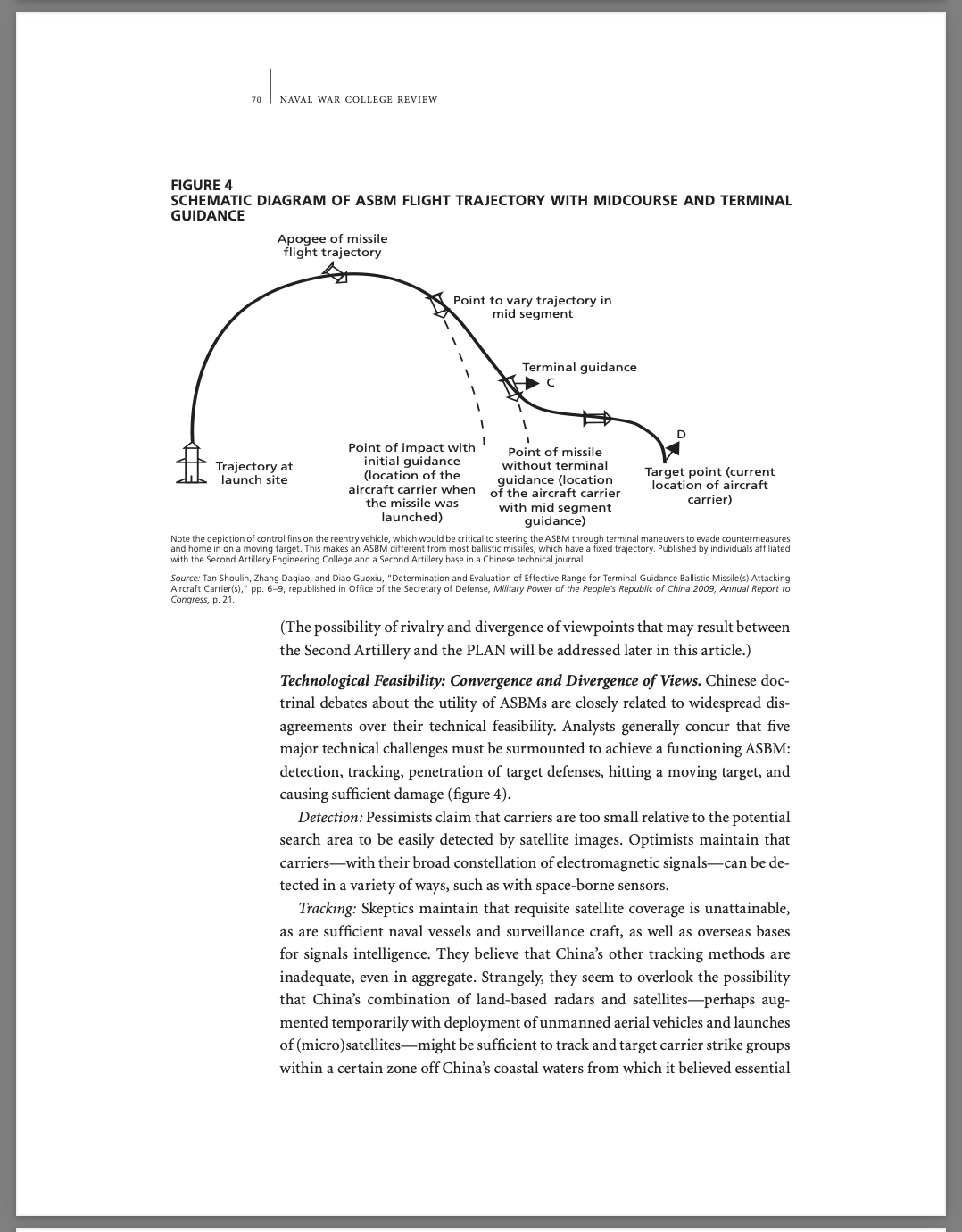Using the Land to Control the Sea? Chinese Analysts Consider the Anti-Ship Ballistic Missile
Andrew S. Erickson and David D. Yang, “Using the Land to Control the Sea? Chinese Analysts Consider the Anti-Ship Ballistic Missile,” Naval War College Review 62.4 (Autumn 2009): 53–86.
- This article won the Naval War College Foundation Hugh G. Nott Prize (second place) in 2009.
- Established in the early 1980s, this award is presented by the President of the Naval War College to the authors of the best non-historical articles in the Naval War College Review over the previous publishing year.
- It has been posted on U.S. Fleet Forces Command Website, and is a featured link in Wikipedia’s “Anti-Ship Ballistic Missile” entry.
China’s open-source literature does not establish whether that nation has, or is close to having, tactical ballistic missiles capable of effective attacks on surface ships. It does establish, however, that the Chinese are deeply interested in the idea—a potential “game changer” that would critically influence America’s place in the Pacific for decades to come—and heavily engaged in the issues involved, technically and otherwise.
For China, the ability to prevent a U.S. carrier strike group from intervening in the event of a Taiwan Strait crisis is critical. Beijing’s immediate strategic concerns have been defined with a high level of clarity. The Chinese are interested in achieving an antiship ballistic missile (ASBM) capability because it offers them the prospect of limiting the ability of other nations, particularly the United States, to exert military influence on China’s maritime periphery, which contains several disputed zones of core strategic importance to Beijing. ASBMs are regarded as a means by which technologically limited developing countries can overcome by asymmetric means their qualitative inferiority in conventional combat platforms, because the gap between offense and defense is the greatest here. … … …
IMPLICATIONS
While there is ongoing disagreement as to their feasibility and efficacy, the idea of developing antiship ballistic missiles is clearly appealing to many in China, particularly in the Second Artillery. Any successful Chinese deployment of ASBMs would likely influence PLA thinking by
- Reinforcing continental approaches to maritime security—“using the land to control the sea”
- Reinforcing centralized approaches to command
- Increasing emphasis on multiaxis saturation attacks
- Increasing confidence in China’s ability to restrict U.S. Navy operations, and to control escalation.
All does not hinge on putative ASBM capability: demonstration of other antiaccess capabilities (e.g., streaming antiship cruise missile attacks) that a technologically capable nation like China is clearly capable of mastering could have substantial effect. But ASBMs pose a threat qualitatively different from that of antiship cruise missiles: the United States has not had decades to address the problem, interception is far more complex and time sensitive, and launch platforms cannot be targeted (“shooting the archer instead of the arrow”) without contemplating highly escalatory strikes in mainland China.
Chinese leaders do not seek war. Rather, they want to defend what they perceive to be their nation’s core territorial interests and to ensure a stable environment for domestic economic development. If they develop an ASBM, then, they would likely hope that it could prevent U.S. projection of military power in ways that were inimical to China’s interests. They would thus hope to achieve deterrence without going to war. That said, America has its own national interests, including maintaining freedom of navigation, reassuring such key regional allies as Japan and South Korea, preserving peace in the Taiwan Strait, and safeguarding Taiwan’s democracy. A demonstrated Chinese ASBM capability, particularly if the Chinese side failed to offer explanations and reassurances, could threaten these interests and be strategically destabilizing. This would necessitate American development and demonstration of robust countermeasures that Beijing would come to regret.91
Herein lies one more way in which Chinese open-source discussions of ASBMs are significant, and must be addressed. Chinese public intellectuals are often tasked by their government with making unofficial statements to gauge international response to potential initiatives, as was the case in December 2008 before a far more positive historic first—the PLAN’s counterpiracy deployment to the Gulf of Aden. If some Chinese are currently sending such “trial balloons” with regard to ASBM development, but U.S. interlocutors appear to be unaware, distracted, or indifferent, this will only strengthen the hand of those pushing such programs forward. Measured expression of U.S. concern, resolve, and capability, on the other hand, might influence Chinese decision-making regarding ASBM development in a more positive direction—for example, by informing and empowering the voices of government organizations with more to lose than the Second Artillery in provoking the United States—or at least slow the pace to give time for a more measured reaction. Just as American policy makers must now discuss how best to prepare for this potential capability, they should work to ensure that their Chinese counterparts have an analogous policy debate—in parallel to the ongoing debate in open sources regarding whether China should develop and deploy an ASBM, and the doctrinal and usage implications if it does. While China will ultimately keep its own counsel, like any nation, such efforts should at least ensure that any decisions in favor of ASBM development are made with full awareness of the contingent costs, risks, and consequences. To facilitate this process, two areas require particular investment of political and human capital:
• Increased research to understand the trajectory of both Chinese ASBM efforts and the attendant policy discourse92
• Bilateral strategic dialogue at all levels (particularly tracks 1.5 and 2).
Responding to the unprecedented strategic challenge presented by an ASBM capability would require the American military and civilian leadership to face hard truths, and continue to develop innovative new capabilities. The United States has many options here, and it must be prepared to exercise them. The most perilous approach would be to neglect such military innovation while continuing to insist that the United States maintained its ability to keep the peace, when in fact the military capabilities that underpin that ability were diminishing, at least in a relative sense. Such a discrepancy between rhetoric and reality would erode America’s regional credibility and fuel Chinese overconfidence. The prospect of documenting that discrepancy publicly might motivate China to conduct a demonstration of an ASBM; a successful test could create the impression that American power-projection capabilities—and the regional credibility that depends on them—had been dramatically diminished. Managing the proper response to this potential “game changer” will demand close scrutiny from scholars, analysts, and policy makers alike, as it will critically influence America’s place in the Pacific for decades to come.

